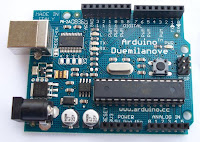Audible Navigation Assistant for the Blind
Objectives:
- Make blind persons able to avoid obstacles in their path.
- Provide binaural 3D sound cues so the user can locate the obstacle.
- Device should provide both position and distance information to the user.
Proposed solution major components:
- Use of infrared camera mounted on the user's head (Wii remote).
- Headphones to provide binaural 3D sounds.
- Infrared emitters in obstacles so they can be detected (Arduino boards with infrared LEDs).
- A computing device, be it a Laptop, netbook or smartphone which will provide the binaural 3D cues.
- Infrared sensor (Sharp or Panasonic IR sensor) or ultrasonic sensor (Parallax Ping sensor).
Implementation:
The obstacles will consist of Arduino electronic boards, these boards will have an infrared LED which will emit their unique identifier as infrared light pulses using a pre-defined protocol.
The user will wear a pair of headphones which will have a Wii remote attached to it. The Wii remote will be used as an infrared camera which will detect the obstacles infrared pulses and therefore be able to identify the obstacles position in 2D.
With this information, the computing device will play a pre-recorded binaural sound, according to the obstacle's position in 2D.
If time permits, the obstacle's distance from the user could also be notified by increasing or decreasing the binaural cue. To do this, the Arduino boards could be equipped with either an infrared or ultrasonic distance sensor. This way, the Arduino boards could detect when the user approaches them and encode their distance from the user as infrared light pulses along with their unique identifiers. The computing device will now be able to increase or decrease the binaural sound depending on the obstacle's distance.
Other solutions that were considered:
- Using RFID to determine if the user was near an obstacle. As RFID only works in close range, this would only work when the user is really close to the obstacles.
- Using GPS to determine the exact position of the user. This would require that the obstacles be in known positions and there could be GPS signal problems if it was to be used indoor.
Challenges and things to consider:
- As the user will wear headphones and these will reproduce sounds so he can navigate and avoid the obstacles, the user's ability to hear important external or environment sounds could be limited.
List of components and estimated costs:
| Laptop, netbook or smartphone | $ --- | |
| Wii remote | $25 - $40 | |
| Headphones | $10 | |
| Arduino Duemilanove board | $30 | |
| Infrared distance sensor (Sharp GP2Y0A700K) | $19 | |
| Ultrasonic distance sensor (PING sensor) | $30 |
References and support material:
Research on navigational system for the blind using audible instructions:
Navigation System for the Blind: Auditory Display Modes and Guidance
Navigation System for the Blind: Auditory Display Modes and Guidance (Original)
Navigation System for the Blind: Auditory Display Modes and Guidance
Navigation System for the Blind: Auditory Display Modes and Guidance (Original)
Example of remote, directional human voice messages for visually impaired individuals:
Talking Signs
Arduino board:
Arduino
Distance sensors that could be used with the Arduino board:
Ping ultrasonic distance sensor
Infrared distance sensor






